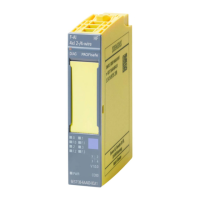Wiring and Fitting Modules
4.5 Requirements for Sensors and Actuators
ET 200S Distributed I/O System - Fail-Safe Modules
Installation and Operating Manual, 08/2008, A5E00103686-07
37
See also
Assignment of the PROFIsafe address (Page 29)
4.5 Requirements for Sensors and Actuators
General Requirements for Sensors and Actuators
Please note the following important information for safety-related use of sensors and
actuators:
WARNING
The use of sensors and actuators is beyond our sphere of influence. We have equipped our
electronics with such safety engineering features as to leave 85% of the maximum
permissible hazardous faults probability for sensors and actuators to you (this corresponds
to the recommended load sharing in safety engineering between sensing devices, actuating
devices and electronic switching for input, processing and output).
Note, therefore, that instrumentation with sensors and actuators bears a considerable
safety responsibility. Remember, too, that sensors and actuators do not generally withstand
proof-test intervals of 10 years as defined in IEC 61508 without considerable loss of safety.
The probability of hazardous faults and the rate of hazardous faults of safety functions must
comply with an SIL-defined upper limit. You will find a listing of values achieved by F-
modules in the technical specifications of the F-modules under "Fail-safe performance
characteristics".
To achieve SIL3 (Category 4/PLe), suitably qualified sensors are necessary.
Additional Sensor Requirements
General rule: A single-channel sensor is sufficient to achieve SIL2/Category 3/PLd.
However, the sensors must be wired to two channels in order to achieve SIL3/Category
4/PLe. However, to achieve SIL2/Category 3/PLd with a single-channel sensor, the sensor
itself must be SIL2/Category 3/PLd-capable, otherwise the sensor must be wired to two
channels in order to achieve this safety level.

